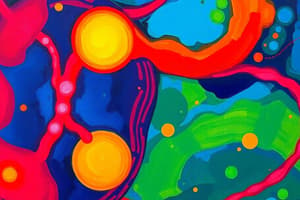Podcast
Questions and Answers
Explain the process of cellular respiration and its role in releasing energy from food.
Explain the process of cellular respiration and its role in releasing energy from food.
Cellular respiration is a process of energy conversion that releases energy from food in the presence of oxygen. It involves breaking down food molecules gradually, capturing a little bit of chemical energy every step along the way. The energy released from food is trapped in the form of ATP, which directly powers the activities of the cell.
Describe the consequences of cellular respiration taking place in just one step.
Describe the consequences of cellular respiration taking place in just one step.
If cellular respiration took place in just one step, all of the energy from glucose would be released at once, and most of it would be lost in the form of light and heat. This would result in the loss of a significant amount of energy stored in the food molecule.
What are the requirements for cellular respiration to occur, and what are the byproducts of this process?
What are the requirements for cellular respiration to occur, and what are the byproducts of this process?
Cellular respiration requires the presence of oxygen and a food molecule such as glucose. The byproducts of cellular respiration are carbon dioxide, water, and energy in the form of ATP.
Why is it essential for a living cell to control the energy released from food molecules?
Why is it essential for a living cell to control the energy released from food molecules?
What is the role of ATP in the activities of the cell, and how is it synthesized during cellular respiration?
What is the role of ATP in the activities of the cell, and how is it synthesized during cellular respiration?
Flashcards are hidden until you start studying




